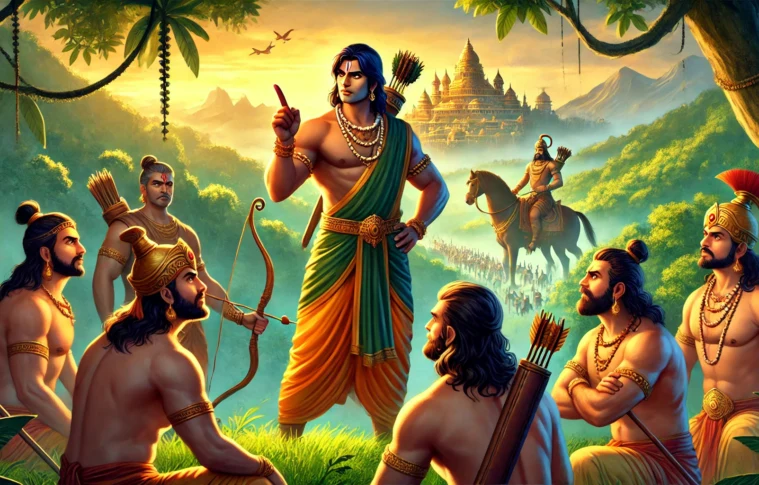The epic Ramayana is not just a story of divine adventures; it is also a profound tale of leadership, teamwork, and the essence of strategic thinking. At the heart of this narrative is Lord Rama, whose qualities as a leader provide timeless lessons for modern professionals. In the battle against Ravana, Rama showcased how effective management and collaboration can lead to success against formidable challenges. Let’s delve deeper into the strategies employed by Lord Rama and how we can relate these lessons to today’s workplace.
1. Clear Vision and Purpose
Rama’s Approach: From the outset, Lord Rama was driven by a singular mission: to rescue Sita from the clutches of Ravana and restore dharma (righteousness). His unwavering focus on this goal inspired those around him. Rama articulated his purpose clearly, which united diverse groups under a common objective.
Modern Application: In contemporary work environments, a clear vision is crucial for team cohesion. Leaders should communicate the organization’s goals transparently, ensuring that every team member understands how their contributions fit into the bigger picture. When employees see the relevance of their roles in achieving a shared mission, their motivation and commitment soar.
2. Diverse Skill Sets
Rama’s Approach: Rama recognized that a diverse team could tackle challenges more effectively. He assembled an army consisting of monkeys and bears, each with unique strengths—Hanuman’s unparalleled strength, Sugriva’s strategic acumen, and others’ loyalty and courage. This diversity allowed them to approach problems from various angles.
Modern Application: Today’s leaders should embrace diversity in their teams. Different backgrounds and skill sets lead to innovative ideas and solutions. By fostering an inclusive environment that values diverse perspectives, leaders can harness the collective strengths of their teams. Encourage collaboration between individuals with different expertise to enhance problem-solving capabilities.
3. Empowerment and Trust
Rama’s Approach: One of the hallmarks of Rama’s leadership was his ability to empower his team. He trusted Hanuman with the critical task of locating Sita, allowing him to take initiative and lead the search. This not only motivated Hanuman but also built loyalty and commitment within the ranks.
Modern Application: Trust is a cornerstone of effective teamwork. Leaders should delegate responsibilities, allowing team members to take ownership of their tasks. When employees feel trusted, they are more likely to innovate and take calculated risks. Establishing an environment where team members feel empowered fosters a sense of belonging and increases engagement.
4. Collaboration and Communication
Rama’s Approach: Rama maintained open lines of communication with his allies. He encouraged discussions on strategies and welcomed input from his team, ensuring everyone was aligned. This collaboration was essential in devising the plan to confront Ravana.
Modern Application: In today’s fast-paced work environment, open communication is vital. Leaders should promote a culture of transparency where team members feel comfortable sharing their ideas and concerns. Regular team meetings and feedback sessions can enhance collaboration, leading to better decision-making and increased team morale. The more connected the team feels, the more effectively they can work together toward common goals.
5. Strategic Planning
Rama’s Approach: Rama exemplified strategic thinking throughout the campaign against Ravana. He carefully planned each phase of the battle, considering the strengths and weaknesses of both his forces and his enemies. His tactical decisions, from building the bridge to Lanka to organizing the attack, were based on thorough assessments of the situation.
Modern Application: Strategic planning is essential in any project or initiative. Leaders must analyze their team’s capabilities and identify potential obstacles. Developing a flexible strategy that can adapt to changing circumstances is critical. By involving team members in the planning process, leaders can leverage their insights and experiences, resulting in more effective and well-rounded strategies.
6. Moral Integrity and Ethics
Rama’s Approach: Rama is often regarded as the epitome of dharma, or moral righteousness. His ethical conduct throughout the narrative earned him the respect and loyalty of his team. He faced numerous challenges yet remained committed to his principles, reinforcing the importance of integrity in leadership.
Modern Application: In the modern workplace, ethical leadership is paramount. Leaders who demonstrate integrity foster trust within their teams and contribute to a positive organizational culture. Upholding ethical standards encourages employees to act in alignment with the organization’s values, which can lead to higher morale and productivity. When leaders prioritize ethics, they create an environment where everyone feels safe and valued.
7. Celebrating Success and Learning from Failure
Rama’s Approach: After significant victories, such as constructing the bridge to Lanka, Rama celebrated his team’s accomplishments. He recognized the importance of morale and team spirit. Conversely, after setbacks, like the initial failure to rescue Sita, Rama encouraged his team to learn from their experiences and adapt their strategies.
Modern Application: Celebrating successes, both big and small, is crucial in maintaining team morale. Leaders should acknowledge individual and team achievements, fostering a sense of accomplishment. Additionally, creating a culture that views failures as learning opportunities promotes resilience and innovation. Encourage team members to reflect on their experiences, extract lessons, and apply them to future challenges.
Conclusion
The leadership qualities exhibited by Lord Rama during his battle against Ravana provide valuable insights for modern leaders. By embodying principles such as clear vision, diversity, empowerment, collaboration, strategic planning, integrity, and a focus on celebrating success, today’s professionals can cultivate high-performing teams capable of overcoming any challenge. The story of Rama teaches us that with the right leadership approach, we can navigate the complexities of our own “battles” in the workplace, ultimately achieving success and fulfilling our missions.



